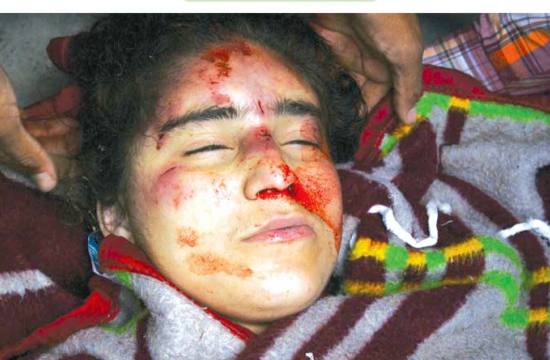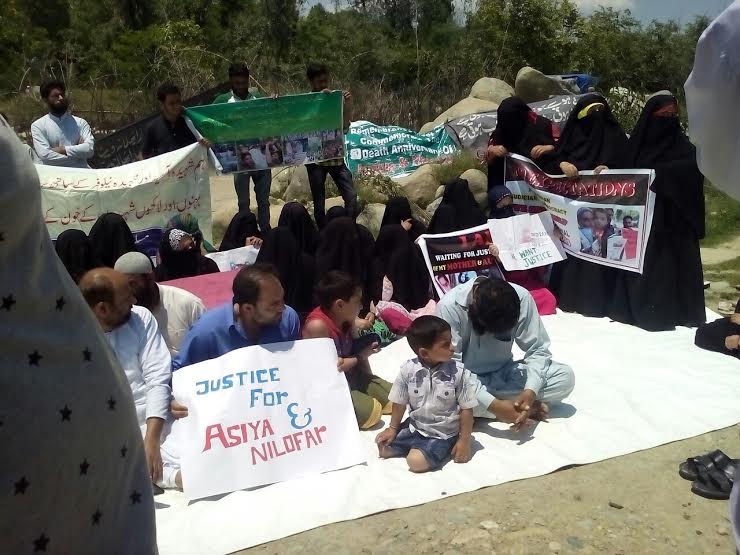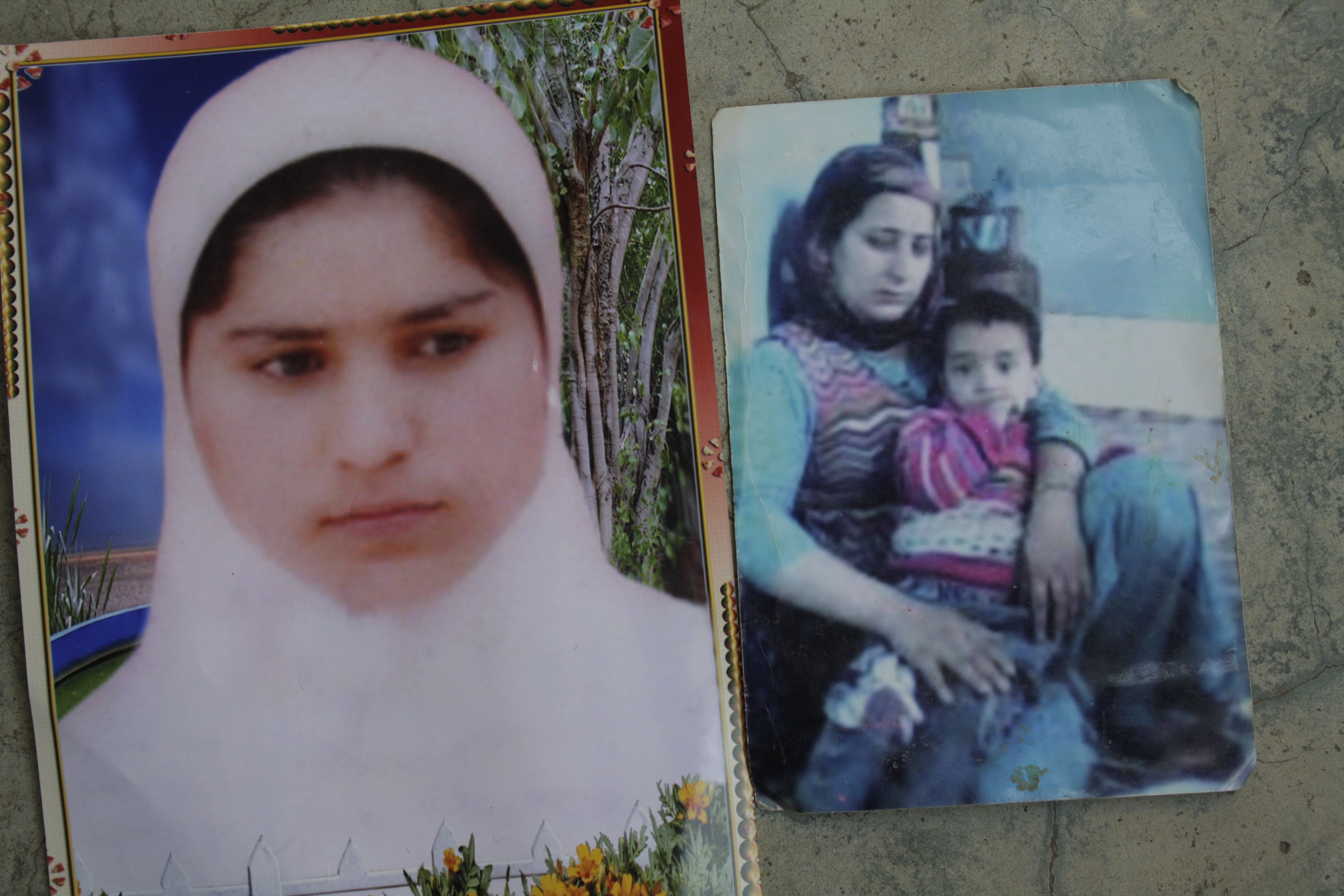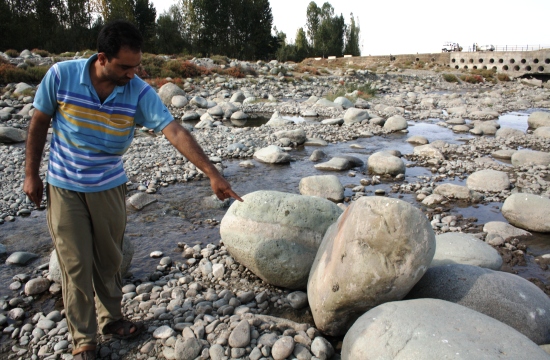JK Government’s one-man inquiry commission to probe the alleged rape and murder of a women and a teenage girl in Shopian, has its task cut out. It has three basic questions to answer – what was the cause of death, whether the two women were raped before death and who the culprit was. Zubair A Dar and Shah Abbas piece together the events of the tragedy from circumstantial evidence and the glitches that make the inquiry more complicated than it appears.
Nearly a week of unrest after the mysterious death of a pregnant woman and her teenage sister-in-law in south Kashmir’s Shopian town, details about the incident are still sketchy; compounded by government’s near siege of Shopian.
On Thursday, Chief Minister Omar Abdullah diluted the government stance on the issue. “Something has happened in Shopian,” he told newsmen. “We will find out,” he added.
While his statement marked a subtle change in the government’s handling of the post incident situation, the task to find out the truth about the fate of the two women has been assigned to a one man commission, Justice (Retired) Muzaffar Jan. On June 08, he will begin recording testimonies of people who might have been witness to the last moments of the woman and the teenager. Except for one person, however, fewer have claimed to know anything about their journey back home.

Neelofar, 22, and Asiya, 17, were sisters-in-law. Neelofar, whose parents live in Tukru village on Srinagar Shopian road, was the mother of a 2-year-old son and family claims that she had conceived again. A housewife, Neelofar was married to Shakeel Ahmad Ahangar in 2006. Asiya, Shakeel’s sister, was a class XI student who had passed her matriculation with a distinction.
The two had left for their orchard around 4 pm on Friday, May 29. Their bodies were found 13 hours later, lying on the bank of a stream that flows along the edge of the Shopian town.
Was it a death by drowning as government claimed initially? Or the two women had been killed. The mystery has to be solved by Justice Jan. The crucial help will come from the Forensic Science Laboratory report that is examining the samples taken during two autopsies conducted on the bodies. But the real challenge comes from the general perception among people in the area created by the events before the bodies were found.

As Neelofar and Asiya did not return by sundown, their family had begun to grow apprehensive about their fate. Their fear was not unfounded. Heavy presence of security forces in the area makes every family nervous if a member does not report back before dusk. And when it comes to women, the concern grows deeper as incidents of molestation and rape by security forces are no rarity in Kashmir. Neelofar’s husband, Shakeel Ahmad Ahanger, had by then closed his furniture shop in the main market and reached home.
Shakeel says he had seen his wife last when he had come home for lunch around 3:30 pm that Friday. “When I left, my wife was preparing to leave for the orchard. Asiya was yet to return from her school. I left before Asiya came,” he says.
“As I reached home after closing my shop at around 7:45 pm, I looked for Asiya. My (second) sister Roomi told me that she had gone with my wife to the orchard,” he says. “It was already beginning to grow dark. I thought they must be on their way home by now and so sent my brother’s son Aqib to receive them midway and accompany them safely home.”

(Shakeel Ahmad Ahangar Photo: Bilal Bahadur)
Aqib returned around 15 minutes later and said he could not find them. He had not gone beyond the old bus stand. Worried, Shakeel says, he borrowed his neighbour’s motorcycle to reach the orchard around two kilometers from their house. “It had little fuel in it. I went to fill the tank first,” he says. He had to go to three refilling stations to find fuel. “It took around 30 minutes to refill the tank. I then headed for the orchard but I did not find them there.”
A family that lives near the orchard was the only source Shakeel could find some information from. So he approached them. “The house owner (Ghulam Qadir) told me that they had seen my wife and sister leaving the orchard and walking towards the bridge to cross the stream towards Shopian town. He said they had left around the time evening prayers are offered,” he says.
Hoping to find them on that route, Shakeel set off in the same direction. He says he looked everywhere along the route, but could not find them. “I came back and again asked Ghulam Qadir. He advised me to search again on the same route. I was hoping that they had entered some nearby home fearing to walk home in dark. But no one could give me any clue about their whereabouts,” Shakeel says.
Anxious, Shakeel returned home to seek help in tracing the two. “I called a friend and told him about the situation. He came to my house and we left together to continue our search. This time, we took a lantern along for light,” he says. “We searched every corner of the orchard and asked people along the way if they had seen my wife and sister. No one had any clue.”
In the meantime, Shakeel’s elder brother Zahoor reached the orchard with another lantern in hand. Failing to trace the two, they decided to contact police. “At the Police Station Riyaz, (the munshi), registered my complaint and immediately sent some men in a Tata 407 vehicle to look for my wife and sister,” he says. Police says it was around 11:45 pm when the complaint was registered. The search party kept looking for the two around the area where the women had been seen last. The search continued till 2:30 am but no trace was found.
Police abandoned the search and decided to wait for first light to resume. Shakeel says that he and his brother Zahoor went to the Police Station in the morning, hoping that some police men would accompany him. “They were taking time to prepare. So we left to keep searching till they come,” he says. “Eventually, the SHO arrived. He spotted the body of my wife (Neelofar) from a distance at the same spot where we had looked twice during the night.”
Shakeel and others who along with police recovered the body from the spot claim that it was lying on the bank of the stream. “Only the legs were in water. The shirt had been pulled up to make the body bare. I think she had been murdered and the body placed there,” he said.
But police contradicts the claim. “I saw some clothes floating on the surface of water. It appeared to me that they must be of some women,” says SHO Shopian, Shafiq Ahmad. “I asked my men to check. The body was found,” he says.

Downstream, Zahoor and other residents located Asiya’s body around an hour after Neelofar’s body was spotted. Zahoor says it was lying on the bank. “It was placed away from water,” he says. While Neelofar’s body was taken to the hospital for autopsy, Asiya’s body was first brought to the family’s home at Bongam neighbourhood of Shopian town but was soon shifted to hospital for autopsy. Here the situation took a twist.
The news of the recovery of the bodies of two women had already spread in the town like wildfire. While doctors were preparing for an autopsy, people from different neighbourhoods of the town started pouring in. Soon, the mob was beginning to grow restless.
Inside the hospital, the job of conducting an autopsy was assigned to Dr Hilal Dalal who soon sought Dr Nazia’s assistance. The female doctor’s job was to ascertain whether the women were raped or not. A paramedic, who was called in to assist in autopsy told Kashmir Life that ascertaining whether the women had been raped or not was possible only through a PV examination.
“But the bodies were too stiff that legs could not be moved apart,” the paramedic said. “So the only way to find out was a PV examination that could not be conducted unless joints were stressed to move the legs. That could have broken the joints. Dr Nazia expressed incompetence in doing that, fearing loss of crucial evidence.”
The paramedic’s statement is corroborated by the women who gave the bodies their funeral bath. One among the women, Zamrooda, lives in the neighbourhood. She says that Neelofar had reddish marks on the right side of her back and the outer side of her right arm. “There were no other injuries. The jewellery was intact but the fists were clenched. We had to cut the rings on fingers and the gold bangles on arms to remove them,” she said.

(File Photo of Asiya and Neelofer)
Another woman who gave Asiya’s body its funeral bath lives in a neighbouring locality. She says Asiya’s body was as fair as would have been if she was alive. “So any marks or injuries would have been very visible,” she says. “There was a cut on her head. Blood was oozing out of her nose probably because of the head injury. There were reddish marks on her forehead but no injury mark was visible on her body. Her left leg had a small wound above the ankle.”
If the death was not due to violence or rape, did the two women drown? Chances, the locals say, are least. “The stream has little water to drown an adult,” say the locals. Doctors who carried out the autopsy at the Shopian hospital say the bodies did not appear to have remained in water for long. “The bodies were not swollen the way a drowned person’s body is,” said a doctor. “The skin grows pulpy if the body remains in water for long. That too had not happened.”
Add the women who performed the last rites, “When we wash utensils at home, the hands soften due to constant contact with water. The bodies had grown no such softness.”
If the women drowned, the death must have taken place within a short period after they left the orchard. Doctors say 12 hours of contact with water are enough to grow any such signs. And then, how can both drown when the water level in the stream in not high? The stream, in fact, is one among a dozen small streams that collectively form the nullah Ramb-i-Aar. It roars only during rains and floods and for most of the year the water discharge is low.

(Ahanger pointing towards the spot where one of the two bodies were found – Photo by: Bilal Bahadur)
If the women did not die of drowning, murder seems the likely possibility. The task of the team of doctors was to ascertain the actual cause of death and to examine whether the duo had been raped before being finally killed. Another possibility was death during rape. At the hospital, as the first team of doctors was struggling to carry on a PV examination, restless mob allegedly started pelting stones on the mortuary where autopsy was going on. Dr Bilqees, who had just arrived to assist, was not able to carry on any further. The breaking of window panes, doctors say, forced them to flee. By then, however, the doctors had taken samples of viscera – one kidney, one lung and a part of the spleen.
As restless mob entered the mortuary, doctors were compelled to leave. Doctors say that they had reached no conclusion about possibility of rape as procedures were too complicated and could have been carried out only by expert gynecologists. After some strife between administration and the family which was backed by local people, a decision to carry out a second autopsy was made. A team of doctors was called in from Pulwama district hospital to do the expert job.
By that time, the family had grown very apprehensive about the autopsy report as well. “So we made doctors swear to reveal the truth about the autopsy findings after they finished their job,” says Syed Abdul Hai, Neelofar’s father. “After they came out, Dr Nighat Chiloo put her hands on her face and cried ‘O Allah, better grant the daughters of Kashmir death. This treatment is not met even with animals’.”
The woman who gave Asiya her funeral bath supports Dr Nighat’s statement. “Her private parts indicated that she had been raped,” she says. A mother of three children, she maintains that figuring out whether a rape had been committed in case of an unmarried woman was easier.
While Dr Nighat’s statement and the woman’s testimony led people to conclude that Neelofar and Asiya had been raped, the preliminary autopsy report by the team of doctors is yet to be made public. In fact, Omar Abdullah, in a news conference on Monday stated that no rape had been established. The contradictory statements by Dr Nighat and the government stirred unrest across the valley. Omar later retracted his statement when he said that ‘something had happened.’
Experts, however, say that any conclusion reached should be backed by forensic examination of the smear. The report, according to government, is lying with the FSL. However, the circumstances put a question mark on the credibility of the government institutions.
Apart from the PV examination, which experts say is complicated in case of a body with a rigor mortis – a condition where body grows stiff after six hours of death. In such a case, the smear tests can prove helpful by identifying the presence of sperms and even lead to identification of the culprit by DNA mapping.
Tracking the culprit only on the basis of sperm samples, however, is even more challenging unless the circumstantial evidence has pointed to some suspects. People in Shopian allege security forces for the ‘heinous crime’. They base their allegation on the manner in which the bodies reached the spot where search parties finally located them.

(Graves of Asiya and Neelofer in Shopian Photo: Bilal Bahadur)
The spot where Neelofar’s body was found is just a couple of hundred meters away from the CRPF camp and is in close vicinity of District Police Lines building that houses hundreds of policemen. Any movement of people in this area, locals point out, should have been tracked by the CRPF who maintain a constant vigil at night by searchlights. “Why wouldn’t they be able to track people who placed the body there at night,” says Neelofar’s brother, Syed Shahnawaz.
The family members believe that the body was placed at the spot rather than being washed ashore by the water current. They say that they visited the spot twice before they stopped their search at 2:30 am that night. “The body was placed near the stream after we left. How otherwise would it reach there?” says Shakeel.
Victims’ family also alleges police of lowering their guard by abandoning the search till dawn. They say that the time gap gave culprits crucial time to place the body near the stream.















